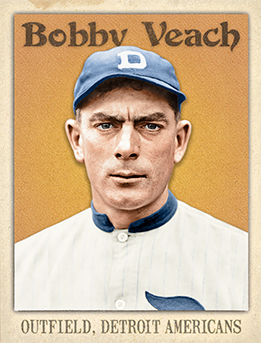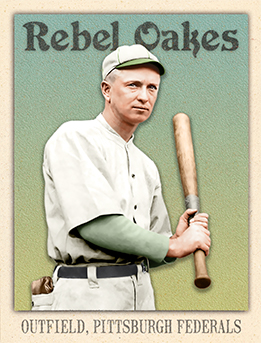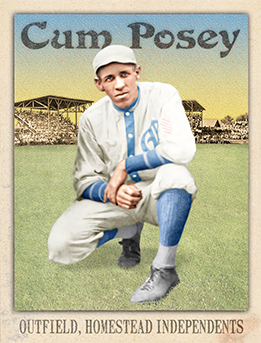
- Series: Diamond Heads '15
- City: Detroit
- Team: Tigers
- League: American League
Robert Hayes Veach (1888-1925) took over in left field at Navin Field in Detroit on Sept 6, 1912 and held that post until 1924 when the Tigers traded him to the Red Sox. In his decade-plus as wingman to Ty Cobb, along with Harry Heilmann and Sam Crawford, Veach was part of the most potent outfield in history. Many, including Bill James, peg the 1915 Tigers’ outfield the best of all-time. Because he played somewhat in the shadow of these greats, and perhaps because the Tigers never won a World Series, this veteran with a lifetime .310 average and top-of-the-league production at the plate and in left, never made it to Cooperstown. As good as he was before the war years, 1919 was Veach’s pinnacle. He led the AL in hits, doubles and triples. Only Cobb bested his .355 average and only Ruth topped his 101 RBI and 279 total bases. In 1920 Veach became the first Tiger to hit for the cycle. From 1915 to 1922, nobody drove in more runs or had more extra-base hits than Bobby Veach.
- Playing for the Yankees in his final season, on Aug 9, 1925, Bobby pinch-hit for Ruth, the first time that had happened since Babe left the mound
- Veach ended his dazzling ML career with pennant-winning Washington that same year

- Series: Diamond Heads '15
- City: Pittsburgh
- Team: Rebels
- League: Federal League
Ennis Telfair Oakes (1883-1948) came north from tiny Lisbon, LA and Louisiana Industrial Institute (now LA Tech University) to play his rookie season in the majors with Cincinnati in 1909. Rebel wasn’t the most productive hitter for the team. In fact, while only three other starters had higher averages, every other starter drove in more runs. Oakes was sold to the Cardinals the next season where he started in center until being lured to the Federal League in 1914. He had his best season with St. Louis in 1913, hitting .293 and exceeded that with the Pittsburgh Federals who even took his name: The Rebels. In their minor league incarnation, the franchise had been called the Filipinos after manager Deacon Phillippe, so the team was inclined toward the identity of whomever was at the helm. The “major league” status of the Federal League is certainly open to debate, however a number of Oakes’ teammates had MLB experience before and after their stint with the “outlaw” Federals. He served well as player-manager, hitting a career best .312 in 1914.
- Rebel left MLB when the Federal League folded after the 1915 season, but he went out to Denver to manage the Western League’s Bears where he led the circuit with 205 hits

- Series: Beginnings: 1880's
- City: Sioux City
- Team: Corn Huskers
- League: Western Association
C. Frank Genins (1866-1922) had a modest career as a utility fielder for three major league clubs in the 1890s. Frenchy had started out getting paid to play ball with the Omaha Omahogs of the Western League in 1887, en route to a total of 16 years in the minors. He concluded his playing days with the Racine Belles of the Wisconsin-Illinois League in 1909, having also managed in his latter seasons for three teams. Whether in the farm leagues or the bigs, Genins was consistently mediocre at the plate. His MLB average was .226. His most plate appearances came with Sioux City in 1894 where Frenchy had his best output, batting .374 with seven home runs. He exceeded .300 a couple other times so he had some decent seasons along the way. Genins’ stints in the majors were with his hometown Browns in ‘92 (one game?), the Reds for a longer trial that year, the Pirates in ‘95 and with Cleveland’s Blues in 1901. Frenchy had a respectable season in Pittsburgh, hitting .250, playing seven positions, and was the only outfielder to spell the team’s beloved trio of Mike Smith, Patsy Donovan and Jake Stenzel.
- Frenchy has five known poses in the Old Judge series and all five come in a curious variant: Genins is oftentimes misspelled as "Genius." The editors of the Photographic Baseball Cards of Goodwin & Co. conclude that the misspelling is an error, but I am inclined to disagree. Considering the amount of intentional humor interspersed throughout the Old Judge canon, the fact that the misspelling is prevalent across Frenchy's entries, and perhaps most tellingly that one must only flip an "n" upside down in Genins to turn Frenchy into a "Genius" - and I am inclined to believe that this misspelling was indeed purposeful at the hands of the Goodwin pranksters.
- Series: Beginnings: 1880's
- City: New York
- Team: Giants
- League: National League
Michael Joseph Tiernan (1867-1918) overcame early miscues (a still-MLB-record 5 errors in a game & giving up a 10-run 10th inning in relief) to become a model of stability and decorum for the NY Giants, playing exclusively for them his entire 13-yr career. His bat trumped all else. “Silent Mike” was 4th in 19th Century HRs and batted .311 lifetime.
- Tiernan’s bat was key to the NY triumphs in the ’88-89 “world series”
- His outstanding year in ’91 silenced any animosity felt by returning teammates who had formed the ill-fated Players’ League

- Series: Diamond Heads '15
- City: Homestead
- Team: Grays (IND)
- League: Independent
- Hall: National Baseball Hall of Fame
Cumberland Willis Posey Jr, (1890-1946) was a brilliant, gifted and driven man, on the basketball court, the boxing ring, the diamond and the front office. He starred as Penn State’s first black hoops player, played at Pitt and Duquesne before founding his Black Five entry where the team won four straight Colored Basketball World Championships. He was an owner and columnist for the Pittsburgh Courier, managed a boxing team and, by the way, built the Homestead Grays into one of the dominant franchises in Negro League history. Posey wasn’t big (5’9” and 145 lbs) but he excelled at every sport he tried. Yet, it was as player/manager/executive of the Grays from 1911 to 1946 that Cum made an indelible mark on American sports. Eleven of the 18 Negro League-era players in the Hall of Fame when Posey was inducted had played for him at some point. He had an unerring eye for talent and recruited the best, even in the face of fierce competition.
- Posey’s Grays had been a force in Negro ball through the ‘20s and 30’s but never more so than during their unparalleled surge to nine straight league championships, a string that ended with this remarkable man’s untimely death from lung cancer on the very eve of Jackie Robinson’s matriculation
- Elected to Hall of Fame: 2006




